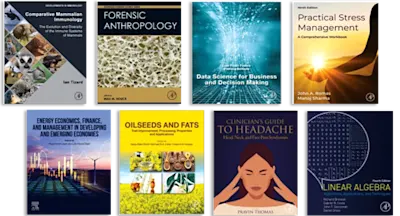
Weighted Residual Methods
Principles, Modifications and Applications
- 1st Edition - October 30, 2017
- Imprint: Academic Press
- Author: Mohammad Hatami
- Language: English
- Paperback ISBN:9 7 8 - 0 - 1 2 - 8 1 3 2 1 8 - 0
- eBook ISBN:9 7 8 - 0 - 1 2 - 8 1 3 2 1 9 - 7
Weighted Residual Methods: Principles, Modifications and Applications introduces a range of WRMs, providing examples that show how they can be used to solve complex engineeri… Read more

Purchase options

Institutional subscription on ScienceDirect
Request a sales quoteWeighted Residual Methods: Principles, Modifications and Applications introduces a range of WRMs, providing examples that show how they can be used to solve complex engineering problems with greater accuracy and computational efficiency. Examples focus on non-linear problems, including the motion of a spherical particle, nanofluid flow and heat transfer, magnetohydrodynamic flow and heat transfer, and micropolar fluid flow and heat transfer. These are important factors in understanding processes, such as filtration, combustion, air and water pollution and micro contamination. In addition to the applications, the reader is provided with full derivations of equations and summaries of important field research.
- Includes the basic code for each method, giving readers a head start in using WRMs for computational modeling
- Provides full derivations of important governing equations in a number of emerging fields of study
- Offers numerous, detailed examples of a range of applications in heat transfer, nanotechnology, medicine, and more
Researchers/MScs working on projects involving heat transfer, nanotechnology, nanofluid flow, or particle mechanics.
Chapter 1: Introduction to analytical methods
1.1 Introduction
1.2 Adomian Decomposition Method (ADM)
1.3 Variational Iteration Method (VIM)
1.4 Differential Transformation Method (DTM)
1.5 Homotopy Perturbation Method (HPM)
1.6 Homotopy Analysis Method (HAM)
1.7 Weighted Residual Methods (WRMs)
1.8 Differential Quadrature Method (DQM)
1.9 Optimal Homotopy Asymptotic Method (OHAM)
1.10 References
Chapter 2: Weighted Residual Methods (WRMs) principles and modifications
2.1 Introduction
2.2 Weighted Residual Methods (WRMs) principles
2.2.1 Collocation Method (CM)
2.2.2 Least Square Method (LSM)
2.2.3 Galerkin Method (GM)
2.2.4 Rayleigh–Ritz Method (RRM)
2.3 WRMs for coupled equations
2.4 Optimal WRMs for infinite boundary conditions
2.5 Combined WRMs with other analytical methods
2.6 Modified WRMs for Combined Boundary Conditions
2.7 Hybrid WRMs for partial differential equations
2.8 Multi-step Polynomial WRMs for fractional order differential equations
2.9 Padé Approximation and Other Analytical Methods
2.10 References
Chapter 3: WRMs in Fluid Mechanic Applications
3.1 Introduction
3.2 Nanofluid flow in porous channel
3.3 Nanofluid flow between parallel disks
3.4 Jeffery-Hamel flow
3.5 Condensation flow over inclined disks
3.6 Electro-hydrodynamic (EHD) flow
3.7 Magneto-hydrodynamic (MHD) flow in divergent/convergent channels
3.8 Nanofluid flow in Micro-channel Heat Sink (MCHS)
3.9 Nanofluid flow in expanding and contracting gaps
3.10 References
Chapter 4: WRMs in Heat Transfer and Energy Conversion Applications
4.1 Introduction
4.2 Heat Transfer of Longitudinal Convective-Radiative Porous Fins
4.3 Heat Transfer of Circular Convective-Radiative Porous Fins
4.4 Heat Transfer of Convective–Radiative Semi-Spherical Fins
4.5 Refrigeration of Fully Wet Circular Porous Fins
4.6 Refrigeration of Fully Wet Semi-spherical Porous Fins
4.7 Nanofluids Condensation and Heat transfer
4.8 Nanofluids Heat Transfer in Circular Concentric Heat Pipes
4.9 Nanofluids Heat Transfer in Microchannel Heat Sink (MCHS)
4.10 References
Chapter 5: WRMs in Nano-Engineering Applications
5.1 Introduction
5.2 Natural Convection of Non-Newtonian Nanofluid
5.3 MHD Jeffery–Hamel Nanofluid Flow
5.4 MHD Nanofluids over a Cylindrical Tube
5.5 Forced convection for MHD nanofluid flow over a porous plate
5.6 Non-Newtonian nanofluid in porous media between two coaxial cylinders
5.7 MHD nanofluid flow in a Semi-Porous Channel
5.8 Nanofluid in Microchannel Heat Sink (MCHS) cooling
5.9 Carbon Nano-Tube (CNT)-Water between Rotating Disks
5.10 References
- Edition: 1
- Published: October 30, 2017
- No. of pages (Paperback): 384
- Imprint: Academic Press
- Language: English
- Paperback ISBN: 9780128132180
- eBook ISBN: 9780128132197
MH